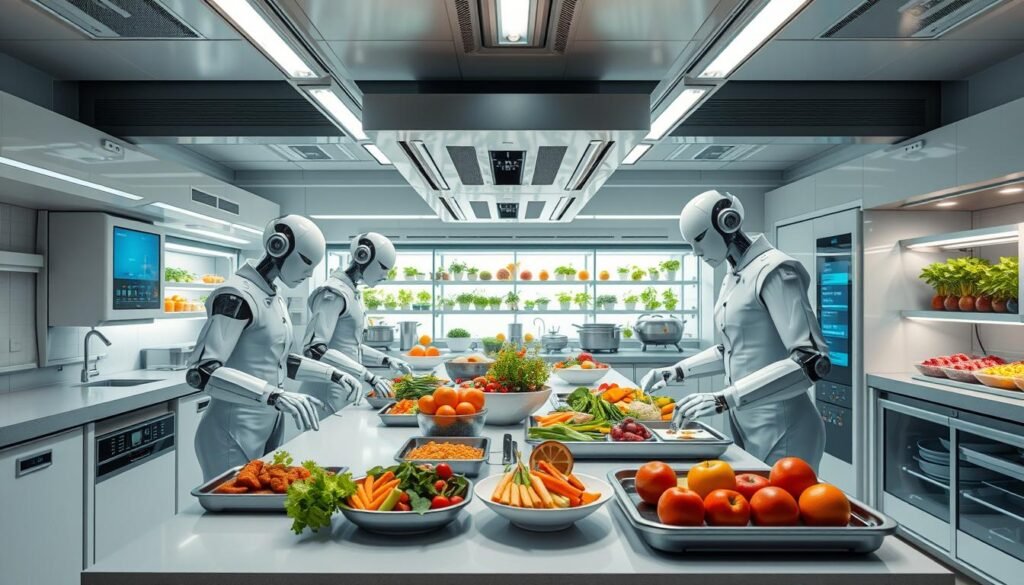Reflect on the profound impact a meal can have on a patient’s recovery path. In the healthcare domain, the significance of meticulously crafted hospital catering solutions has emerged as a pivotal factor in patient care. By integrating the right strategies in healthcare meal delivery and hospital dining services, medical establishments can markedly improve patient outcomes. This is achieved through the provision of nutritious and tailored meal options. This discourse elucidates the foundational elements of healthy hospital catering, highlighting its indispensable role in promoting overall wellness and facilitating recovery.
Key Takeaways
- Healthy hospital catering can enhance patient recovery and overall well-being.
- Well-planned meal solutions are essential for nutritional balance in patient diets.
- Personalization in meal options plays a critical role in patient satisfaction.
- Fresh ingredients are vital for optimal taste and nutritional value.
- Healthcare meal delivery systems must prioritize efficiency and patient preferences.
Understanding the Importance of Hospital Catering
Hospital catering transcends the mere provision of sustenance, embodying a pivotal role in the holistic care of patients. It is not merely about feeding; it is a cornerstone in the support of recovery and health. The provision of balanced nutrition is instrumental in the healing process, delivering vital vitamins and minerals that bolster strength and promote wellness.
Research underscores the profound psychological benefits of appealing meals. Patients who receive well-prepared meals exhibit enhanced mood and overall satisfaction with their hospital stay. This correlation underscores the significance of meal quality in patient contentment, affirming the imperative that food service for hospitals should be a paramount concern.
Several factors underscore the criticality of hospital catering:
- Balanced nutrition: Meals must include the right mix of nutrients to support the healing process.
- Psychological benefits: A well-presented meal can improve patient morale.
- Quality of meals: High-quality food increases customer satisfaction, making patients feel cared for.
Grasping these facets of the importance of hospital catering elucidates the necessity for hospitals to invest in effective food service. Such investment prioritizes patient nutrition and satisfaction, leading to enhanced patient experience and improved recovery outcomes. This underscores the critical focus healthcare providers must place on this area.
What Makes Healthy Hospital Meals Essential?
Healthy hospital meals are pivotal in facilitating patient recovery, catering to the diverse nutritional requirements of each individual. These needs are influenced by a myriad of factors, including health conditions, age, and activity levels. Thus, it is imperative that meals are tailored to enhance overall patient well-being.
Key components of healthy hospital meals include:
- Balanced Macronutrients: Ensuring an optimal ratio of carbohydrates, proteins, and fats is essential for promoting healing and maintaining energy levels.
- Vitamins and Minerals: A variety of fruits and vegetables are crucial, providing vital vitamins necessary for recovery.
- Dietary Fiber: Whole grains and legumes are vital for digestion and contribute to overall health.
Customized meal plans are designed to meet the specific nutritional needs of patients, addressing a range of health conditions from chronic illnesses to post-surgical recovery. Research underscores the significance of personalized menus, demonstrating a substantial impact on patient recovery rates. By aligning meal choices with the unique health requirements of patients, healthcare facilities can create a more conducive environment for healing.
Balancing Nutrition and Taste in Patient Menu Options
The quest for harmonizing nutritional value with palatability in hospital culinary endeavors is a complex endeavor. Chefs and nutritionists collaborate intensively to craft patient menu options that meet dietary standards while captivating the taste buds of those in need. Several strategies are pivotal in achieving this equilibrium:
- Incorporating herbs and spices: The judicious use of a broad spectrum of herbs and spices can dramatically enhance the gustatory experience of dishes, thereby increasing patient enjoyment.
- Attractive meal presentation: A visually stimulating presentation can significantly elevate the dining experience, prompting patients to relish their meals more fully.
- Focus on diverse textures: The inclusion of varied textures, such as the contrast between crunchy vegetables and smooth sauces, introduces a layer of excitement to patient menu offerings.
Studies affirm that meals that are both aesthetically pleasing and nutritionally sound foster greater patient contentment and enhanced nutritional consumption. Emphasizing both nutrition and taste is instrumental in bolstering the recovery trajectory and enriching the hospital experience for patients.
Key Components of Effective Food Service for Hospitals
The provision of nutritious and palatable meals in hospitals relies on several critical elements. These components must synergize to fulfill dietary requirements while upholding culinary excellence. The synergy between hospital administrators, culinary professionals, and nutritionists is foundational. It ensures that meals are not only nutritionally sound but also of superior quality.
Optimal food sourcing is indispensable for the efficacy of hospital meal services. The selection of fresh, premium ingredients significantly boosts the nutritional profile of meals. The application of appropriate preparation techniques is crucial for maintaining both the flavor and nutritional value of dishes. Techniques must prioritize taste, safety, and hygiene.
Staff training is a cornerstone of successful hospital food service operations. Adherence to health and safety standards is imperative. Staff must be proficient in managing diverse dietary needs. Regular training enhances staff awareness and accountability, leading to enhanced patient dining experiences.
Case studies underscore the advantages of integrating these components effectively. Institutions that adopt structured meal planning, rigorous food sourcing, and comprehensive staff training witness enhanced patient satisfaction and nutritional outcomes. Prioritizing these elements enables healthcare facilities to establish a more effective food service model. This model significantly improves patient care.
Hospital Catering: Meeting Dietary Requirements for Patients
Hospital catering is pivotal in addressing the differing dietary requirements for patients. It necessitates the adaptation to various needs stemming from allergies, intolerances, and chronic health conditions. The provision of a daily menu that accommodates specific dietary restrictions is imperative for patient recovery and satisfaction.
Diverse dietary requirements, such as diabetic, renal, and gluten-free diets, necessitate meticulous meal planning. Nutrition experts collaborate with kitchen staff to ensure meals not only fulfill dietary requirements for patients but also provide vital nutrition. Several measures enhance hospital catering’s capacity to meet these diverse needs:
- Detailed assessments of patients’ dietary restrictions.
- Customized meal planning based on the latest nutritional guidelines.
- Regular training for kitchen staff about food allergies and preparation techniques.
Engaging patients in meal selection is crucial. Communication facilitates the refinement of menus according to individual preferences and health requirements. The implementation of feedback mechanisms enables catering teams to continually enhance their offerings and adapt to the needs of all dining patients. Recognizing the broad spectrum of dietary restrictions is essential for fostering a supportive environment for patient recovery. To explore healthier eating options, visit Healthy Eating.
Innovative Healthcare Meal Delivery Systems
The transformation of healthcare meal delivery is revolutionizing the domain of hospital food services. By embracing cutting-edge food service technology, institutions are transitioning to systems that prioritize patient-centric meal options and elevate service efficiency. The advent of online ordering platforms and mobile applications empowers patients to directly choose their meals, thereby fostering a more bespoke dining experience. The integration with electronic health records is pivotal, enabling the creation of customized meal plans that adhere to dietary restrictions and patient preferences.
The Role of Technology in Hospital Meal Services
Technological advancements are reshaping the administration of hospital meal programs. Interactive systems facilitate the seamless management of meal selections. Real-time updates enable kitchen staff to prepare meals in advance, thus reducing wait times. These innovations streamline the meal preparation process, ensuring that food is delivered hot and fresh, aligning with patient needs and schedules.
Ensuring Timely Delivery for Optimal Patient Satisfaction
Timely meal delivery is paramount for enhancing patient satisfaction. Prompt delivery of meals positively influences patient perception of their care experience. Strategies for efficient service include scheduled meal rounds and the operation of centralized kitchens that prepare meals based on patient needs. Case studies indicate that hospitals adopting these strategies experience improved meal quality and adherence to dietary guidelines. For further insights on meal strategies, explore fat loss strategies.
Customizable Patient Menu Options for Diverse Needs
In the domain of hospital catering, the provision of customizable patient menu options is paramount for addressing the varied requirements of patients. This adaptability enables healthcare establishments to accommodate diverse dietary restrictions, thereby ensuring that each patient receives meals that are meticulously tailored to their unique preferences. By emphasizing personalized meal planning, hospitals can significantly elevate patient satisfaction and overall health.
Addressing Common Dietary Restrictions
Healthcare providers must navigate several prevalent dietary restrictions, including:
- Low-sodium diets for patients with hypertension.
- Vegetarian and vegan options for plant-based eaters.
- Allergen-free meals to prevent adverse reactions.
- Diabetic-friendly choices that control blood sugar levels.
By addressing these dietary restrictions, hospitals can develop customizable patient menu options that align with the 9 necessary nutritional guidelines while meeting individual health needs.
Incorporating Patient Preferences in Meal Planning
Incorporating patient preferences into meal planning significantly enhances the dining experience. Engaging patients through surveys and feedback mechanisms reveals what they enjoy and prefer in their meals. This knowledge is crucial for:
- Improving patient satisfaction with hospital meals.
- Encouraging better adherence to dietary regimens.
- Fostering a sense of autonomy and comfort during recovery.
With a focus on patient input, healthcare facilities can create customizable patient menu options that resonate with individual tastes and foster a positive dining experience.
Importance of Fresh Ingredients in Hospital Dining Services
In the domain of hospital dining services, the significance of fresh ingredients is paramount. The incorporation of fresh produce and whole foods elevates the nutritional caliber of meals, thereby positively influencing patient recovery and overall health. Studies affirm that meals crafted with fresh ingredients exhibit superior taste, enabling patients to savor their meals even in the most trying of times.
The procurement of fresh ingredients within a hospital setting, however, presents unique hurdles. The variability in availability can impede the consistent provision of high-quality meals. Forming alliances with local farms serves as a pivotal strategy to overcome these challenges. Such partnerships guarantee a consistent flow of seasonal vegetables and fruits, fostering both health and community engagement. By adopting these approaches, hospital dining services can uphold a commitment to quality and nutrition, thereby creating a welcoming dining environment for patients.
- Improved patient satisfaction through flavorful meals.
- Enhanced nutritional value supporting faster recovery.
- Community engagement through local sourcing.
Engagement with local agricultural producers offers sustainable solutions, concurrently reducing the carbon footprint associated with extensive transportation. Hospitals are increasingly acknowledging the importance of integrating fresh, locally-sourced ingredients into their menus. These initiatives underscore a dedication to patient health and environmental stewardship. A deeper comprehension of fresh ingredient utilization can stimulate creative meal planning strategies that accommodate a wide range of dietary requirements.
The Role of Hospital Kitchen Staff in Meal Preparation
The proficiency of hospital kitchen staff is indispensable in crafting meals tailored to patients’ distinct nutritional demands. Mastery over special dietary needs is paramount, facilitating the creation of dishes that align with both medical necessities and personal tastes.
Training for Special Dietary Needs
Training initiatives for hospital kitchen staff significantly augment their comprehension of special dietary requirements. These programs delve into various critical areas, including:
- Identifying prevalent dietary restrictions, such as gluten-free or low-sodium.
- Grasping the nutritional prerequisites for specific ailments, like diabetes or cardiovascular conditions.
- Adopting rigorous food handling protocols to avert cross-contamination.
Such training has been demonstrated to elevate food service standards and patient contentment.
Collaboration Between Nutritionists and Cooks
Efficient meal preparation hinges on the synergy between hospital nutritionists and kitchen personnel. The efficacy of their collaboration is underscored by clear communication and teamwork, leading to enhanced meal quality. This synergy can:
- Refine meal planning by integrating precise dietary mandates.
- Design menus that resonate with patient preferences and nutritional exigencies.
- Guarantee safety and compliance with dietary restrictions through mutual understanding.
Studies affirm that when nutritionists and kitchen staff collaborate, it profoundly benefits patients, delivering meals that are both palatable and nutritious.
Case Studies: Successful Hospital Catering Solutions
In the United States, numerous hospitals have revolutionized their food service operations through the adoption of innovative catering solutions. These case studies offer insights into various strategies that have significantly enhanced patient satisfaction and nutritional outcomes.
A notable example is a major healthcare facility that overhauled its meal preparation methodology. By adopting a patient-centric approach, they introduced customizable meal options tailored to diverse dietary needs. This shift led to a substantial increase in patient meal satisfaction scores.
Another case study highlights a hospital’s collaboration with local farms to source fresh produce. This initiative not only bolstered local agriculture but also elevated the nutritional value of meals. Patients’ appreciation for the meal’s freshness significantly improved, enhancing their dining experiences.
The integration of technology in meal ordering has also proven beneficial. A healthcare institution introduced a digital system enabling patients to order meals from their hospital rooms. This innovation not only boosted patient satisfaction but also optimized kitchen operations, resulting in enhanced efficiency.
These examples are but a few among many successful hospital catering solutions. Each case study underscores the critical role that effective food service plays in promoting health and well-being within medical settings.
Enhancing Patient Experience Through Meal Presentation
The significance of a patient dining experience in the realm of hospital catering is frequently underestimated. The presentation of meals significantly impacts patients’ perception and enjoyment of their food. Skilled chefs employ various techniques to transform mundane meals into visually stunning dishes. This transformation not only enhances the food’s appeal but also elevates the hospital’s overall ambiance.
Studies reveal that deliberate meal presentation can significantly elevate the perceived taste and enjoyment of the dishes served to patients. For instance, introducing color contrast, garnishing with fresh herbs, and arranging food artfully on the plate can dramatically increase its appeal. These elements contribute to a more engaging dining experience, encouraging patients to actively participate in their meals.
Effective techniques employed by chefs include:
- Utilizing vibrant, fresh ingredients that capture attention.
- Incorporating different textures to create interesting variations.
- Plating foods in a manner that highlights their unique characteristics.
Enhanced meal presentation not only improves flavor perception but also enriches the patient dining experience. Patients who engage with their meals are more likely to feel satisfied and nourished. Moreover, well-presented meals can diminish anxiety and foster a sense of normalcy during difficult times. For further insights on implementing these practices, refer to this informative article on the subject here.
Collaborating with Local Farms for Fresh Produce

Hospitals are increasingly recognizing the substantial advantages of partnering with local farms to procure fresh produce. This endeavor not only elevates the nutritional caliber of the meals provided but also fortifies community bonds and instills environmental stewardship.
Supporting Sustainable Eating Practices
Choosing locally sourced ingredients enables hospitals to actively participate in sustainable eating initiatives, thereby diminishing their ecological footprint. This cooperative strategy incentivizes local farms to adopt eco-friendly agricultural methods, enhancing biodiversity and curtailing the application of detrimental chemicals. Consequently, patients are served meals brimming with fresh, seasonal fruits and vegetables, harvested at their zenith of ripeness, thereby maximizing both taste and nutritional benefits.
The Benefits of Seasonal Menus
Implementing seasonal menus that incorporate locally sourced produce offers manifold benefits. These menus not only intensify flavors but also serve as a platform for hospitals to impart knowledge on healthy dietary practices. By synchronizing meal plans with the availability of ingredients, hospitals can curate menus that showcase the finest offerings from local farms throughout the year. This flexibility fosters a deeper connection to the regional food culture, transforming dining into a more satisfying and culturally enriching experience.
Challenges Faced by Hospital Food Service Teams
Hospital food service teams confront a myriad of challenges in hospital food service that impede their operations. Budgetary limitations severely restrict their capacity to procure superior ingredients and introduce novel meal alternatives. Furthermore, the task of catering to the varied dietary requirements of patients introduces an additional layer of complexity. Each patient’s preferences and restrictions are unique, necessitating a tailored approach to meal planning.
Logistical hurdles further exacerbate the food service barriers encountered in healthcare environments. The procurement of ingredients, the maintenance of freshness, and the timely delivery of meals are critical yet daunting tasks. Effective coordination among kitchen personnel, nutritionists, and healthcare professionals is imperative to streamline these processes and elevate operational efficiency.
Facilities that successfully navigate these challenges employ several strategies. Investing in the continuous training of food service personnel enhances their meal preparation skills. The integration of technology for tracking patient meal preferences facilitates the creation of menus that better meet their needs. Moreover, forging robust partnerships with local suppliers ensures a steady supply of fresh produce while reducing costs.
Trends in Hospital Catering: A Shift Towards Healthier Options
Hospitals are undergoing a transformation, driven by the evolving needs of their patients. The trend towards healthier meal options is gaining momentum, reflecting a deeper understanding of nutritional requirements. The incorporation of patient feedback has been instrumental in shaping these changes. It enables hospitals to craft menus that align with the preferences of those they serve.
Understanding Patient Feedback
Collecting insights through patient feedback has become crucial in redefining hospital meal offerings. Hospitals engage in surveys and focus groups to grasp preferences and dietary restrictions. This direct input enriches the dining experience and fosters a sense of involvement among patients. Key aspects include:
- Identification of popular meal choices.
- Recognition of specific dietary needs.
- Incorporation of culturally significant dishes.
The focus on promoting healthy eating habits is a central trend in hospital catering. By actively listening to patient feedback, hospitals can tailor their meal offerings to meet individual preferences. This leads to enhanced satisfaction rates among patients. The recent emphasis on vibrant, nutritious meals is a testament to the advancement of patient-centered care.
Evaluating the Impact of Healthy Hospital Catering on Recovery
The impact of healthy catering on recovery is a critical component of patient care, underscoring its indispensable role. Extensive research underscores the pivotal role of nutritional intake in the recovery process. Hospitals now acknowledge the significance of offering meals that not only satiate hunger but also facilitate healing. Studies reveal that patients consuming well-balanced, nutritious meals experience shorter recovery periods and superior health outcomes.
Case studies illustrate the successful integration of enhanced meal programs across diverse healthcare settings. These initiatives frequently result in elevated patient satisfaction and a significant decrease in complications. Nutritionists collaborate with culinary teams to design menus tailored to patients’ specific needs, demonstrating the profound and quantifiable impact of healthy catering on recovery. Recent data confirms a direct correlation between enhanced dietary practices and improved recovery metrics.
Nutritional education for both patients and healthcare staff is crucial in maximizing these advantages. By enhancing understanding of how food impacts health, hospitals empower patients to make informed dietary choices during their stay. This approach extends the impact of healthy catering on recovery beyond the dining room, influencing patient behavior both during and after their hospital stay.
Future Innovations in Medical Facility Catering

The evolution of medical facility catering is witnessing a significant shift towards embracing future innovations. These advancements aim to elevate the dining experience for patients. A notable trend is the integration of plant-based options into hospital menus. Such meals align with health-conscious initiatives, offering numerous benefits that support patient recovery and overall well-being.
Exploring Plant-Based Options
Hospitals are increasingly recognizing the positive impact of nutrition on health. The adoption of plant-based options represents a promising avenue for future innovations in catering. Chefs are now venturing into creativity, developing recipes that cater to diverse palates while adhering to dietary restrictions. These meals provide essential nutrients, reduce the risk of chronic diseases, and enhance recovery time.
Innovative chefs and nutritionists are working together to design meal plans that showcase the versatility of plant foods. From hearty legumes to vibrant vegetables, the possibilities for delicious dishes are endless. Offering patients appealing choices encourages them to adopt healthier eating habits.
- Enhanced flavors through spices and herbs
- Variety in dishes to prevent menu fatigue
- Increased accessibility to nutrient-dense foods
Exploring delicious healthy meals can inspire hospital kitchens to expand their plant-based offerings. Engaging patients in the meal selection process enhances their satisfaction and overall experience. With a focus on dietary preferences and nutritional benefits, plant-based options not only satisfy hunger but also promote health and healing within medical facilities.
Conclusion
The importance of healthy hospital catering in enhancing patient care and recovery is paramount. This article has delved into the multifaceted aspects of hospital dining, highlighting the role of fresh ingredients and the challenges faced by food service teams. The dedication of healthcare facilities to prioritize health and sustainability is pivotal in shaping the future of hospital dining.
Hospitals are innovating, adapting to evolving dietary needs and preferences, with a focus on integrating healthy options into patient menus. The synergy between kitchen staff, nutritionists, and local farms is critical, ensuring the quality of ingredients. This collaboration significantly benefits patient health and well-being.
The future of hospital dining appears promising, with ongoing efforts to elevate food services and embrace new trends catering to a diverse population. By prioritizing exemplary meal experiences, healthcare providers can transform dining into a vital component of holistic patient care.
FAQ
What are the benefits of healthy hospital catering?
The provision of healthy hospital catering is pivotal in bolstering patient recovery and overall wellness. It ensures the delivery of balanced nutrition, appealing meals, and tailored dietary options that align with individual health needs.
How does hospital catering impact patient satisfaction?
The impact of hospital catering on patient satisfaction is significant. It offers meals that not only adhere to nutritional standards but also cater to patient preferences and dietary requirements. This enhances their overall dining experience.
What types of dietary requirements do hospital meal services accommodate?
Hospital meal services accommodate a wide array of dietary requirements. These include gluten-free, vegetarian, low-sodium, and specialized diets for patients with conditions such as diabetes or renal issues.
How do hospitals ensure the freshness of ingredients in their food service?
Hospitals often partner with local farms to source fresh produce. This ensures that meals contain the highest quality ingredients. Such practices not only promote better taste but also support sustainable eating practices.
Can patients customize their menu options in hospitals?
Yes, many hospitals offer customizable patient menu options. This allows individuals to select meals that meet their specific dietary restrictions and personal preferences. It enhances their overall satisfaction with the dining experience.
What role does technology play in healthcare meal delivery?
Technology plays a pivotal role in enhancing healthcare meal delivery. It streamlines ordering processes and improves communication between kitchen staff and patients. This ensures that meals are delivered accurately and on time.
How important is meal presentation in hospital dining services?
Meal presentation is of paramount importance. It can significantly influence a patient’s perception of taste and enjoyment. Encouraging patients to engage with their food can ultimately support better nutritional intake.
What training do hospital kitchen staff receive?
Hospital kitchen staff undergo training programs focused on understanding special dietary needs, food safety protocols, and collaboration with nutritionists. This ensures they can effectively prepare meals that meet patients’ health requirements.
How do hospitals gather feedback on their food services?
Hospitals often utilize surveys and feedback mechanisms to gather patient opinions on menu options and meal quality. This allows them to adapt and improve their catering services based on patient preferences.
What challenges do hospital food service teams face?
Hospital food service teams face several challenges. These include budget constraints, managing diverse dietary needs, and logistical issues related to food sourcing and timely delivery. Effective strategies are necessary to overcome these challenges.

